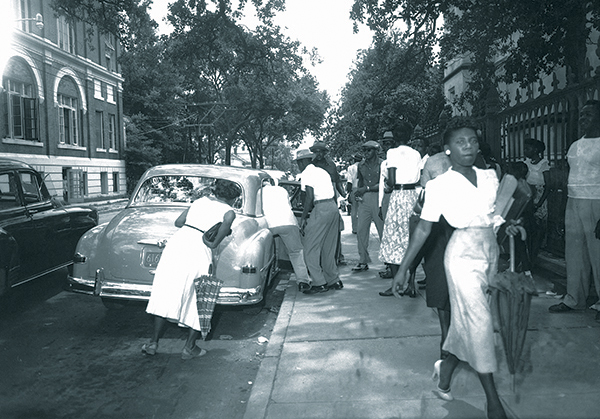
On Friday morning, as the people along Louisiana’s Gulf Coast awaited Barry with bated breath, in Old South Baton Rouge, a pan of cornbread baked in an oven. The baker, Sadie Roberts-Joseph – the well-respected and politically-connected 75-year old founder of the state capital’s Odell S. Williams Then and Now African American Museum, left the bread to rise in her sister’s oven – hers was broken – ‘and the pre-storm weather was perfect for a walk between their two homes.
She never returned to claim it.
Four hours later, police discovered Roberts-Joseph’s body in the trunk of a car on a dead-end street three miles from the sisters’ homes. And so far, that’s everything the public knows about the investigation after more than two days.
Later today, the coroner, Dr. William “Beau” Clark, will complete an autopsy to determine the cause of death. A source close to the on-going investigation says the police are withholding information deliberately – whether that decision was made to obfuscate the truth or to complete a thorough and just investigation we may never know.
Meanwhile, significant questions are going unasked and unanswered: Why would someone leave a car, with a body in its trunk, in a residential neighborhood in broad daylight, particularly on that Friday, when neighbors were almost certain to be home? Why would police not release the color, make, and model of the car especially in light of the $5,000 reward they are offering? To whom was the license plate registered? How did the police even find the car, and what was their justification for searching it? Why aren’t more people – particularly those politicians and community leaders who claim her as a friend – asking these obvious questions publicly?
“I am terribly confused by the anonymously graphic way we have found out about her death, simply that she was found in the trunk of a car three miles from her home,” said Philip Hackney, former LSU Law professor and a founder of the Dialogue on Race-Louisiana. Hackney knew Roberts-Joseph personally. “It’s not right to keep the public in the dark in this way. Not about a matter of such grievous importance to this community.”
After years of work in public service and in medicine, Roberts-Joseph founded the Museum in 2001 upon inheriting posters of notable African Americans from her former grade school teacher, the museum’s namesake Odelle Williams. Ms. Williams had broken the school administration’s rules by using the posters to secretly teach her pupils Black history.
The posters are just one of the Museum’s exhibitions. In the five-room shotgun, tucked below the Interstate-10 overpass that destroyed South Baton Rouge’s Black business corridor in the late 1960s, Roberts-Joseph displayed cotton, a mural-covered city bus from the year of Baton Rouge’s bus boycott, African masks, and other artifacts.
Every year, she also produced the city’s annual Juneteenth Celebration, a memorial of enslaved Texans’ two-years belated first taste of freedom (their enslavers had failed to tell them of the Emancipation Proclamation), this year in collaboration with Mayor Sharon Weston-Broome’s office.
Roberts-Joseph was in the business of empowering, reminding Black people in Baton Rouge of how far they’d come and how much they contribute to the world. Black leaders in Baton Rouge had, after all, conceptualized and pioneered the bus boycott model in 1953 that fired up the engines of the Civil Rights movement; Rev. T.J. Jemison was a founding member of the Southern Christian Leadership Council.

It was no small feat for Roberts-Joseph to open and sustain, for nearly two decades, the city’s African American Museum. Artistic and cultural institutions in Baton Rouge are the most underfunded of any in the urban South. The nonprofit sector, where sustainability is largely dependent on raising funds from private foundations, is notoriously competitive. It can be especially cutthroat where funding is scarce.
In 2014, amidst the nationwide street art craze, the Arts Council of Greater Baton Rouge received $300,000 from the Michigan-based Kresge Foundation for “the development of arts-based planning strategies and the implementation of pilot projects designed to promote economic revitalization in the Old South Baton Rouge neighborhood.”
Roberts-Joseph, along with her city councilman, Tara Wicker, and several other South Baton Rouge residents, issued a cease and desist letter to the Arts Council requesting they put project plans before a body of resident stakeholders before implementation. Instead of doing so, the Arts Council just stopped the projects.
I imagine that hurt like hell for Roberts-Joseph – an outside organization being awarded, I’d estimate, two to three times her annual operating budget to produce projects supposedly for her community when her institution within the community ached for support.
Roberts-Joseph soldiered on though. Because as she was known to say, “Culture is the glue that holds people together,” and she knew herself to be the glue’s key ingredient.

In recent press about the Museum’s Juneteenth celebration, she’d begun rebranding the Museum as the Baton Rouge African American Museum – a shrewd move to market the institution as the sole museum of that kind in the capital and also to connect it to the two other African American museums in Southeast Louisiana, the New Orleans African American Museum and the River Road African American Museum in Donaldsonville.
“It was no secret that (Roberts-Joseph) had plans to expand and develop the museum,” said South Baton Rouge native Sharbreon Plummer, a PhD candidate in Arts Administration at Ohio State University in Columbus. “She definitely wanted to empower people in South Baton Rouge because the community has experienced so much disregard. Anything that encourages self-determination, that disturbs the downhome neutrality we’re supposed to have, is a threat.”
I watched on social media as news articles about Roberts-Joseph’s presumed murder spread through the national Black arts grapevine— artists, curators, scholars, writers, and philanthropists in New Orleans, New York City, Los Angeles, the Midwest. The fear, echoed from coast to coast: Was there a relationship between her murder and the cultural work she was doing?
In a state where, just last year, a series of racially-motivated church burnings were orchestrated by a sheriff deputy’s son and in a city where, just over three years to the date, Alton Sterling was killed by a police officer that state attorney general Jeff Landry chose not to charge – it’s not very difficult to arrive at that question.
If we agree that culture is the glue that holds people together, then if you want people to come apart, the key is to compromise the glue – the keepers of the culture.
Whether or not her murder is related to the cultural work in which she was involved, two questions – with equally alarming implications – still stand: What impact might the death of an elder who had the ears of elected officials, brought the community together through cultural work, and advocated for their cultural autonomy have on the stability of her historically under-resourced neighborhood?
And will the Museum, the only of-its-kind in our state’s majority Black capital, survive this crisis of leadership, the unexpected death of its life-long leader with no succession plan in place?
Though mum may be the word among Baton Rouge’s elected officials and police, time will tell.
(Editor’s note, Tuesday evening, July 16, 2019: Baton Rouge Police arrested and charged a male tenant from one of Miss Sadie’s rent houses with her murder. Allegedly, he was $1200 behind in his rent.)
